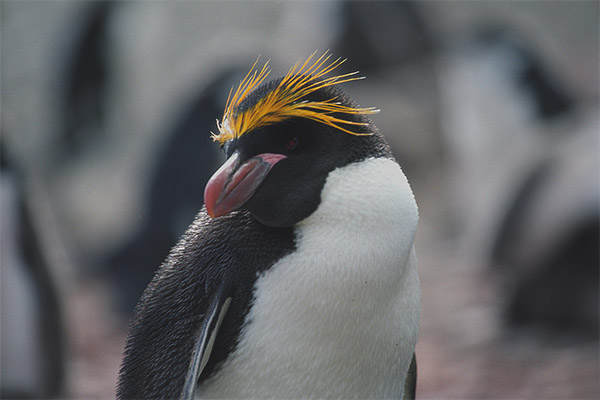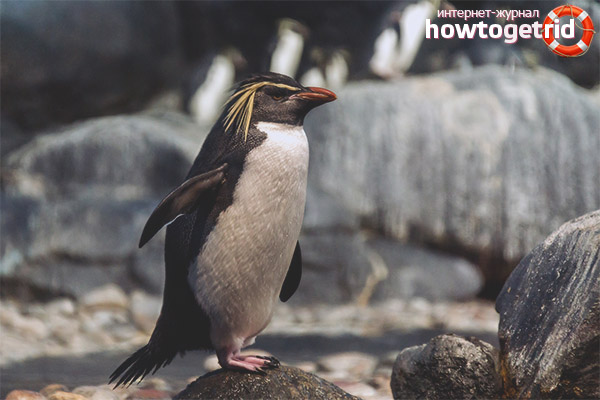The content of the article
The golden-haired penguin got its name due to the presence of a characteristic shade on its head. These beautiful members of the family can compete with distinctive external data. In addition, they are fun and interesting in terms of learning. Many photographers and researchers are happy to go into the natural habitat of penguins to watch them and compose fascinating material.
Features of the form
- For the first time the bird was described by a naturalist from Germany back in 1837. It was he who noticed the crested creature with interesting habits. Initially, this penguin was assigned to a common family, but over time, individuals migrated to a separate classification.
- If you follow the data obtained from numerous studies, then the closest fellow of this bird is considered a penguin of the royal type.Of course, the second species is larger and more massive, but otherwise they are similar.
- More than 1.5 million years ago, the first mutation occurred, the birds were divided and began to change in appearance. Today, these individuals seem completely different, we will focus on the golden-haired member of the family.
Habitat
- Species of the species under discussion prefer to live on the Antarctic coast. They like to live on islands that extend over the sub-Antarctic belt. Other exceptions include plains with an endless snow mass that does not allow access to the water.
- In terms of their habitat, penguins are colonial, so they live in large families. They are met in southern Chile, as well as on the Orkney Islands and the Antarctic Peninsula. According to the expert, these individuals are located in New Zealand, Australia, Brazil and Africa. But their flocks are small and unstable.
- If you consider a specific place of residence, beautiful feathered friends prefer to settle near the rocky terrain. They build nests there, spend most of their lives hiding from enemies in the natural environment.
- Since it was previously mentioned that this species lives colonially, it is necessary to clarify the number of individuals in one family. Attention, it can reach 1.5 million and even more. Therefore, penguins are a handful and often hostile for territory.
- Young animals are not as conflict as grown up birds. The latter often start fights because they are trying to choose the best place to build a home. Interestingly, an unpleasant fishy smell emanates from the family’s habitat area.
- Social activity is quite developed, the birds communicate with exclamations and gestures. In their arsenal a lot of sounds, each of them means something. When the mating season begins, the male sings and thus calls for the females. The females gather in a heap, and the man chooses one and starts the dance.
Description
- An individual of this genus is distinguished by its large overall characteristics. Of course, she cannot compete with the royal penguins, but she is not small either. So, in terms of growth, the bird grows to 70 cm, but there were also larger representatives.
- Differences in gender are present, male representatives are slightly larger than females. An interesting feature is inherent in these birds.They vary in body weight depending on the period of the year. Also shed decently in weight during mating. In general, the mass ranges from 3-6 kg.
- Juveniles, respectively, smaller, but quickly gaining fat reserves as they grow. Before the molt begins, the penguins weigh about 6 kg, then lose weight 1.5-2 times. Initially, these birds were called crested, not golden-haired. This is due to the characteristic tuft on the head, pigmented by a yellow-orange shade.
- The tip is above the eyebrows. It is considered the hallmark of this species. The beak is strong and large enough. It is colored brownish with orange tint. Slightly bent down like a claw.
- For all other parameters, these penguins hardly stand out among similar individuals. They are almost all over the body painted in blue or black. The abdominal part and neck are white. The paws are pinkish, as is the area under the wings.
Diet
- Do not forget that the individuals of this species belong to birds of prey. They do not know how to fly, but this does not prevent them from being excellent hunters under water. Prim it penguins do it quite successfully.
- Adult individuals are fully capable of diving to a depth of more than 65 m. At the same time, they can be under water without oxygen for up to 3 minutes. In addition, before hunting and immersion in water, penguins take a small amount of stones in their mouths. Due to this additional weight allows predators to quickly sink into the water.
- Often, golden-haired penguins hunt for small fish. They also enjoy eating crustaceans and squid. If you look at it from the other side, then while feeding the offspring, the parents try to bring small mollusks and plankton.
- The problem is that the body of the young is rather weak and has not yet fully strengthened. Therefore, the chicks are simply unable to digest larger food. It is for this reason that we can say that parents provide young animals with special "baby" food.
Interesting Facts
- The considered individuals are not listed in the Red Book, however, this species is protected. It is believed that the golden-haired penguins are very vulnerable.
- At the same time, if the situation does not change, such individuals will fall into the Red Book. Birds perish mainly due to the fact that the entire planet suffers greatly ecology.Specifically, penguins are adversely affected by global warming.
Such individuals are unique and are protected as a species that can disappear. The fact is that penguins have few natural enemies, they are destroyed by the aggravation of ecology on the entire planet. In rare cases, seals are attacked by seals and killer whales.
Video: 10 facts about penguins













To send